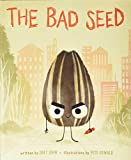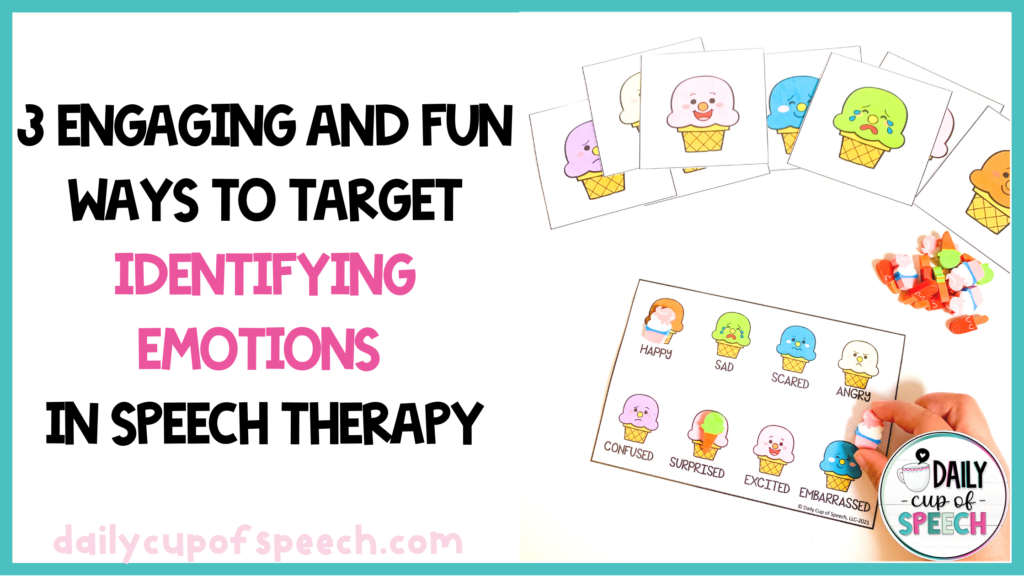Do you always have students working on identifying emotions in speech therapy? Are you looking for identifying emotions pictures, emotion scenario worksheets, or other fun and engaging activities to teach identifying emotions to your students with autism? I have compiled 3 of my favorite ways to teach emotions, including my Ultimate Emotions Unit! Whether it be through books, games, or other activities, there are a variety of options for teaching the important social skills of identifying and expressing emotions!
 Want to try a free sample of my year-round Ultimate Emotions Unit?! CLICK HERE to try the ice cream emojis section of this resource for FREE! The full resource includes 200 printable pages, an interactive PDF for teaching emotions, and a boom deck for extra practice! This Ultimate Emotions Unit includes a variety of materials so that you can select what parts you use based on student needs and grade.
Want to try a free sample of my year-round Ultimate Emotions Unit?! CLICK HERE to try the ice cream emojis section of this resource for FREE! The full resource includes 200 printable pages, an interactive PDF for teaching emotions, and a boom deck for extra practice! This Ultimate Emotions Unit includes a variety of materials so that you can select what parts you use based on student needs and grade.

- Books
One thing I love using when teaching emotions are picture books! I find that books are often highly engaging and students love listening to the story and looking at the pictures. The illustrations of a variety of emotions along with the story are great for helping children identify emotions.
Before reading the book, I do some pre-teaching. I use emotion cards to discuss a variety of emotions, facial characteristics, and situations that may make a person feel that way. Next, we will read the beginning of the book, identify how the characters are feeling and find the matching emotion cards. I like to use the same book for a couple of sessions, as one session is not enough time to pre-teach, read and apply what has been learned. In additional sessions, we will review what happened in the book, use the pictures in the book to practice identifying emotions, and do some extension activities including using emotion scenario worksheets.



A few of my favorite books for targeting emotions in speech therapy are:

2. Ultimate Emotions Year-Round Unit
For many of my students with autism working on identifying and expressing emotions, I find that simple picture cards with faces are not an engaging or fun enough way to teach emotions. I created a year-round identifying emotions resource that includes hands identifying emotions worksheets and activities. This resource includes real human emotion pictures and cartoon kids. It also includes 12 months of emoji themes, to make it perfect for year-round use! The digital component of this resource includes an interactive PDF to have a no-prep, grab-and-go resource for teaching identifying emotions! This huge resource also includes a bonus boom deck for an extra identifying emotions activity! This resource is designed with a variety of activities. For example, blank face mats and task cards for every theme are included for your younger students, while scenario cards and lined writing sheets are included for your older students.

3. Toys For Teaching Emotions
I am obsessed with these toys for teaching emotions! The Big Feelings Pineapple is made by Learning Resources! The pineapple includes a variety of pieces to change the expression on the pineapple. Pair this toy with some real human or cartoon emotion cards (square and task cards included in my Ultimate Emotions Unit), for a low-prep, engaging and fun way to practice identifying emotions! I love that this is a hands-on activity and that it is double-sided allowing you to practice opposite emotions (i.e. happy vs. sad). This toy also comes with an emotions poster, showing the pineapple expressing each emotion.
The second toy includes a set of 6 wooden feeling dolls by My Felt Story. Each of the wooden peg dolls is labeled with an emotion and is great for play-based therapy and pairing with books.

Teaching identifying emotions can be fun and engaging with the right tools! For many of my students, beginning with emoji task cards and drawing or playdough face mats helps with engagement. We work our way up to identifying emotions with cartoon kids and then real human pictures! Based on each student’s individual needs and goals, starting with a different type of activity or on a different level may be more appropriate. There is equivocal research on emotions and facial recognition, specifically for children with autism. There are a few studies on language disorders and emotion deficits, Autism and anthropomorphic (attribution of human characteristics, emotions and behaviors to non-human things) theory of mind, emotion recognition, and more that show using anthropomorphic characters can help with learning emotions.
What are your favorite books and activities for teaching emotions and feelings in speech therapy or your special education classroom? Do you want to try out a free sample of my emotions unit? Scroll to the bottom to get it now!
*Click on the pink text throughout this post to see more details on the specified book, resource or toy. Daily Cup Of Speech is an Amazon affiliate and gets a small commission on anything purchased through Amazon affiliate links. Affiliate links do not change the cost for the buyer.
Enter your email at the bottom of this post, to be sent the free sample now!
Check out more articles about all things language therapy here!
You may be interested in these additional speech-language posts on a variety of topics:
- Back To School Speech Therapy Ideas
- Reasons An SLP is Important To Your Literacy Room
- Activities For Auditory Discrimination
Interested in learning more about blogging? Check out this post:

